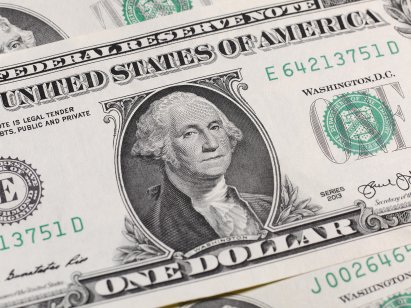
There has been a lot of talk recently about how the US dollar seems to be at the end of its days as the world leading currency. China and Russia have played a key part in leading the de-dollarization efforts, moving away from settling payments in dollars, opting for their own currencies.
Regardless of the motives to do so, it’s not going to be that easy to abandon the dollar, nor is it going to happen in the near future. But the reality is that, alongside the appetite from US enemies to move away from the dollar, the recent sustained pullback in the currency has also fuelled speculation about the end of the dollar era.
Looking at the charts, the dollar’s devaluation has been strong over the past 6 months, but it comes from a position of extreme strength in the post-covid era, which saw the US dollar index (DXY) trading at 20-year highs back in October. A part of this move was brought on by the Federal Reserve’s fierce hawkish stance to combat soaring inflation, which was a stark contrast to other more reluctant central banks at the time, like the Bank of England or European Central Bank.
Since then, the sellers have been out in full force, but the index still remains above its long-term average, which pushes back on some of the doom and gloom. Last week was dominated by the weaker CPI and PPI readings, which evidenced that price pressures continue to subside. This put pressure on US yields and the dollar, as it weakens the Fed’s position of holding the terminal rate unchanged above 5% by year-end, something that markets continue to discount, showing a market-implied rate of 4.5% in December. That said, the selloff was counteracted on Friday as the Fed’s Waller case out with pretty strong hawkish comments, saying that the banking crisis has failed to tighten financial conditions sufficiently and then Fed has done little to combat inflation, suggesting further rate hikes are still on the cards.
The strength in the Chinese data reported this morning, which shows accelerating growth and strong consumer demand after the end of strict lockdowns in the country, has reversed the bullish momentum in the dollar seen yesterday. The dollar index (DXY) has bounced off the 20-day simple moving average (SMA) for the second time this month, suggesting that the path of least resistance continues to be lower in the short-term.
US dollar index (DXY) daily chart
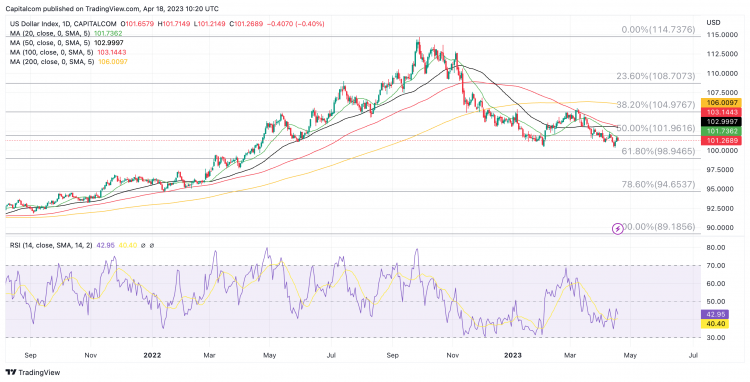 Photo: capital.com. Source: tradingview
Photo: capital.com. Source: tradingviewGBP/USD
GBP/USD continues to show bullish momentum but the strength of the rally has been fizzling out over the past few weeks. There seems to be a short-term double top which has been keeping buyers restricted above 1.25, a key psychological level where there is likely a lot of stops located. This has meant some sideways consolidation between there and 1.23254 and it is likely going to be hard to break out of this area, despite the momentum still pointing upwards.
Of focus this week will be the UK inflation data out on Wednesday as it may paint a clearer picture of how the BOE may act at their meeting in May.
GBP/USD daily chart
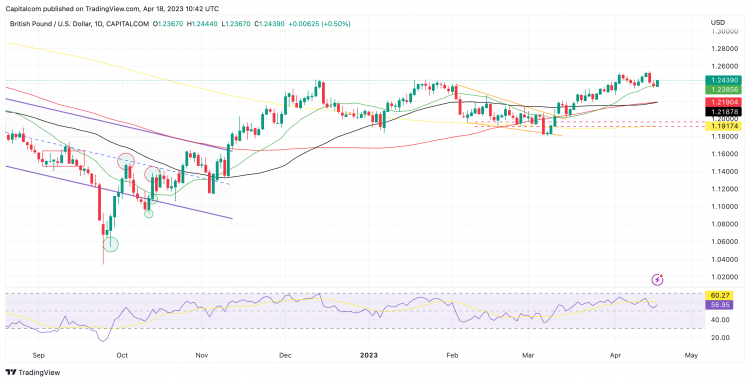 Photo: capital.com. Source: tradingview
Photo: capital.com. Source: tradingviewEUR/USD
Alongside the weakness in the dollar, a lot of the pessimism around Europe last year on the back of the Russia/Ukraine crisis has begun to unwind, which has been helping the Euro. This has allowed EUR/USD to trade at one-year highs, but the pair is struggling to find more momentum to break higher. The ECB is expected to remain on its hawkish path of rate rises, overtaking the Fed and therefore the euro may continue to have an advantage over the dollar.
Looking at the chart, the bullish run in EUR/USD seems more sustainable than in other currency pairs as there has been a fair amount of pullbacks along the way. In fact, the last month has seen a pretty strong bullish pattern of higher lows, creating an ascending trendline, which will likely continue to keep the pair supported as it builds the momentum higher. I think concerns for buyers will arise if the pair drops below 1.0850, but so far it looks like it will continue to make small gains, with an aim at breaking the most recent high at 1.1075.
EUR/USD daily chart
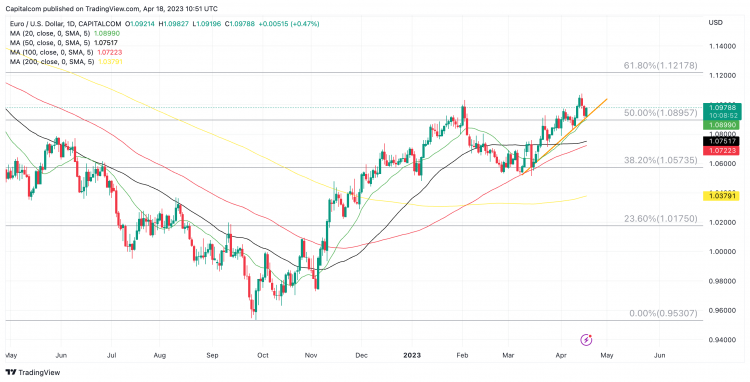 Photo: capital.com. Source: tradingview
Photo: capital.com. Source: tradingviewUSD/JPY
USD/JPY has been following yields higher for the past few days after the comments from Christopher Waller sparked an increase in the market-implied probability of a 25bps hike in May, propping up yields. Unlike the first leg of the pullback, from October to January, which saw a clear downward trend, the US dollar has been regaining some ground and has formed a longer-term pattern of high lows, which has created an ascending (albeit marginally) trendline acting as support. Taking the highs from March 8th and December 15th we can see a horizontal resistance line around 137.80, which is in close proximity to the 200-day SMA (137.13) and therefore the possibility of an ascending triangle, suggesting a topside break may be in play over the coming weeks.
USD/JPY daily chart
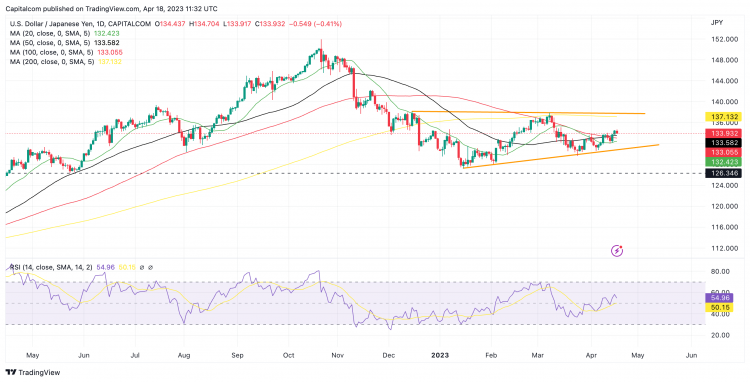 Photo: capital.com. Source: tradingview
Photo: capital.com. Source: tradingview
